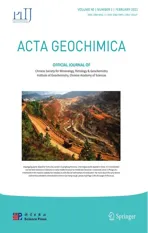Neoproterozoic highly fractionated I-type granitoids of Shillong Plateau,Meghalaya,Northeast India:geochemical constraints on their petrogenesis
2021-03-03DebjaniChoudhuryFaruqueHussain
Debjani Choudhury•M.Faruque Hussain
Abstract There are several Pan-African granitoid plutons widely distributed in Shillong Plateau,NE India.Nongpoh(506.7±7 Ma)and Mylliem(480–430 Ma)plutons were chosen for the petrological and geochemical study to constrain their petrogenesis.Nongpoh pluton consists of coarse-grained porphyritic quartz-monzogranite(NQM)and Mylliem pluton consists of medium to coarse-grained porphyritic granite(MG).The constituent minerals are K-feldspar,plagioclase,quartz,and biotite in both granitoids with accessory minerals of hornblende,zircon,sphene,and ilmenite.Both NQM and MG are metaluminous to weakly peraluminous(A/CNK=0.82–1.06),exhibit varied ranges of SiO2(NQM:58.4–64.9 wt%;MG:66.9–69.9 wt%),and display a clear compositional gap in the Harker variation diagram.NQM contains higher abundances of CaO,MgO and Fe2O3t and similar K2O and total alkali contents compared to MG.They have distinctive geochemical features typical of highly fractionated I-type granitoids such as higher abundances of K2O,Al2O3,MgO,CaO,Al2O3+CaO>15 wt% and A/CNK<1.1,low P2O5 content,enrichment in LILE,depletion in HFSE and HREE and highly fractionated REE patterns with moderate Eu anomalies,implying magma generation in a post-collisional extension setting and thinning induced asthenosphere upwelling,accompanied by the partial melting of the overlying enriched lithospheric mantle.The multi-element diagram of both NQM and MG shows pronounced negative anomalies at Ba,Nb,Sr,P,Zr,and Ti which implies a major role of crystal fractionation in their petrogenesis.High concentrations of Th,U,and Pb in the granitoid types point to additional involvement of crustal components in their generation.However,MGs with more pronounced positive spikes at U,Th,and Pb compared to NQM in multi-element diagram suggests the involvement of more felsic crustal material.The observed geochemical features of the granitoid types thus suggest that they are genetically unrelated to each other and their parental magmas were modified during magmatic differentiation processes.We suggest that the NQM and MG were formed as a result of fractional crystallization of compositionally diverse hybrid magmas produced due to mingling and mixing of an enriched lithospheric mantle-derived melts with lower crust-and middle crust-derived melts respectively during a period of extension late in the cycle of Pan-African orogeny.
Keywords I-type granitoids·Shillong plateau·Geochemistry·Petrogenesis
1 Introduction

Fig.1 Generalized geological Map of Shillong Plateau,Northeast India(modified after Srivastava and Sinha 2004)
The Shillong Plateau,a prominent Archaean gneissic complex in northeast India,has undergone a major continental crustal growth during Early Paleozoic(535–430 Ma:Yin et al.2010;Kumar et al.2017 and references therein)with the emplacement of voluminous granitoid plutons(viz.Myllliem,Nongpoh,Kyrdem,South Khasi).The plutons are widely distributed within the plateau as well as in the Mikir Hills massif,which is a faulted extension of the plateau lying towards the east(Fig.1),and intruded the granite gneisses(1714–1150 Ma)and overlying Proterozoic metasediments of the Shillong Group(e.g.Majumdar and Dutta 2016).Mylliem and Kyrdem plutons are intrusive into the Shillong Group whereas Nongpoh and South Khasi plutons intrude both the granite gneisses and the Shillong Group(e.g.Kumar et al.2017)(Fig.1).The granitoids of these plutons were emplaced in response to the Pan-African orogeny in the eastern Gondwana block during Neoproterozoic(Ghosh et al.2005;Choudhury et al.2012;Majumdar and Dutta 2016;Kumar et al.2017).A-type granitoids linked to the Pan-African orogeny are described from Dizo valley in Mikir Hills massif(Majumdar and Dutta 2016)and Garo Hills in the western parts of the plateau(Choudhury et al.2012).The granitoids of Nongpoh and Mylliem plutons have variable,but often high K2O low CaO and Na2O and P2O5contents similar to I-type granite.They also contain biotite and hornblende and vary from metaluminous to weakly peraluminous as expected for highly fractionated I-type granites(Chappell and White 2001).The petrogenesis of the granitoids of the Nongpoh and Mylliem plutons were not adequately examined previously.In this paper,we present petrography and whole-rock major and trace element analyses for the granitoids for constraining the origin and evolution of the highly fractionated I-type magmatism in a post-collisional extension setting from the Shillong Plateau.
2 Geological setting
Shillong Plateau(SP)represents a Precambrian shield in northeast India,predominantly comprising of an assembly of Palaeoproterozoic basement terrain intruded by several phases of felsic and mafic magmatic rocks underlain by Shillong Group of supracrustals and overlain by Tertiary sediments.The plateau is bounded by Cenozoic faults including the Dauki fault in the south,Brahmaputra fault in the north and Jamuna fault in the west(Fig.1).The Kopili rift in the east separates SP from the Mikir Hills(Fig.1).The basement assembly is composed of amphibolite to granulite facies gneisses(see e.g.,Nandy 2001;Bidyananda and Deomurari 2007;Majumdar and Dutta 2016;Chatterjee 2017),mafic granulites,migmatites,metapelitic granulites,and quartzo-feldspathic gneisses.The Shillong Group of rocks are of Mesoproterozoic age and are represented by a thick pile of quartzites and phyllites.Three distinct episodes of magmatic activity are identified within SP.The earliest episode is a small volume of basaltic magmatism presently represented by metadolerites(locally known as Khasi Greenstones)of Mesoproterozoic age,followed by an extensive episode of granitoid plutonism(535–430 Ma:Kumar et al.2017;Yin et al.2010)represented by South Khasi,Kyrdem,Mylliem,and Nongpoh plutons.The last episode of igneous activity within SP is marked by Sylhet Trap volcanism(117 Ma:Ray et al.2005)and associated Ultramafic-Alkaline-Carbonatite(UAC)magmatism(Ghatak and Basu 2013)(Fig.1).Tertiary sediments flank around the Plateau along its periphery with thicker piles of sediments occurring in the east and south-west(Fig.1).

Fig.2 Geological Map of(a)Nongpoh Pluton(modified after Sadiq et al.2018)and(b)Mylliem Pluton(modified after Ray et al.2011)of Shillong Plateau
The Nongpoh pluton covers an area of~500 km2(Fig.2a)in the northeast of SP while Mylliem pluton covers an area of~100 km2(Fig.2b)towards the southeast of the plateau.The granitoids of both the plutons are undeformed,medium to coarse grained and porphyritic in nature and contain large phenocrysts of K-feldspar(Fig.3a,c–e).At places,the granitoids of both Mylliem and Nongpoh plutons have K-feldspar megacrysts set in equigranular groundmass.Regular occurrences of mafic microgranular enclaves(MME)of various shapes and sizes with sharp to diffuse contacts are a common feature in Mylliem granitoids(Fig.3c,d);specks of sulfide mineralization are also observed in few outcrops.The Nongpoh granitoids are dark grey in color,coarse-grained and porphyritic in nature.Nongpoh granitoids occasionally contain xenoliths of meta-quartzite(Fig.3a)in addition to MMEs.At places,the Nongpoh granitoids show K-feldspar phenocrysts oriented(magmatic flows)along E-W direction(Fig.3e)indicating the presence of moderate melt-water content that imparted sufficient fluidity.
3 Analytical methodology
A large number of samples were collected along north–south traverses roughly passing through the center of the plutons.Thirty fresh granitoid samples(13 samples of Nongpoh pluton and 17 samples of Mylliem pluton)were selected for preparing thin sections following standard techniques and petrographic studies were carried out.Leica Q-win Camera and software are used for microphotography.Following petrographic studies and observations from the alteration point of view,a total of fourteen most fresh granitoid samples(8 samples of Mylliem pluton and 6 samples of Nongpoh pluton)are selected for geochemical analysis.The locations of the analyzed samples are presented in Fig.2.
The major oxides including Loss on Ignition(LOI)are analyzed at the National Centre for Earth Science Studies(NCESS),Thiruvananthapuram,Kerala,India.The major element abundances were analyzed using WD-XRF(Bruker S4 Pioneer sequential WD X-ray spectrometer)on fused glass disks.The standards used during analysis are JG-1 and JG-2.The analytical procedures and the precision and accuracy of the analysis are as discussed in Kumar and Sreejith(2016).Trace elements including Rare Earth Element(REE)analyses of the samples were carried out at Geochemistry Laboratory,National Geophysical Research Institute(NGRI),Hyderabad,India using Inductively Coupled Plasma Mass Spectrometer(ICP-MS)(Perkin Elmer SCIEX-ELAN DRCII).The sample preparation and analytical procedures,accuracy and precision adopted during the analysis are described elsewhere(see e.g.,Balaram and Rao 2003;Satyanarayanan et al.2006).JG-2 and JG-1a are used as standards during the analysis.The detection limits for most of the trace elements including REEs were about 0.01 ng/ml and the precision is better than 6%RSD for trace and REEs.The analyzed major and trace element including REE data are presented in Table 1.
4 Petrography

Fig.3 Photographs of the outcrops of the granitoids from Nongpoh and Mylliem plutons.(a)Nongpoh granitoids containing enclaves of quartzite belonging to Shillong Group of rocks,(b)Mylliem granitoids emplaced into the quartzites of Shillong Group of rocks.The contact area is shown with a broken yellow line.(c,d)Presence of mafic enclaves in Nongpoh and Mylliem granitoids respectively.The enclaves display sharp edges suggesting lesser chances of assimilation.(e)Flow bands of K-feldspars in Nongpoh granitoids,(f)Occurrence of a thin aplitic vein within the Nongpoh granitoids indicating another younger magmatic pulse
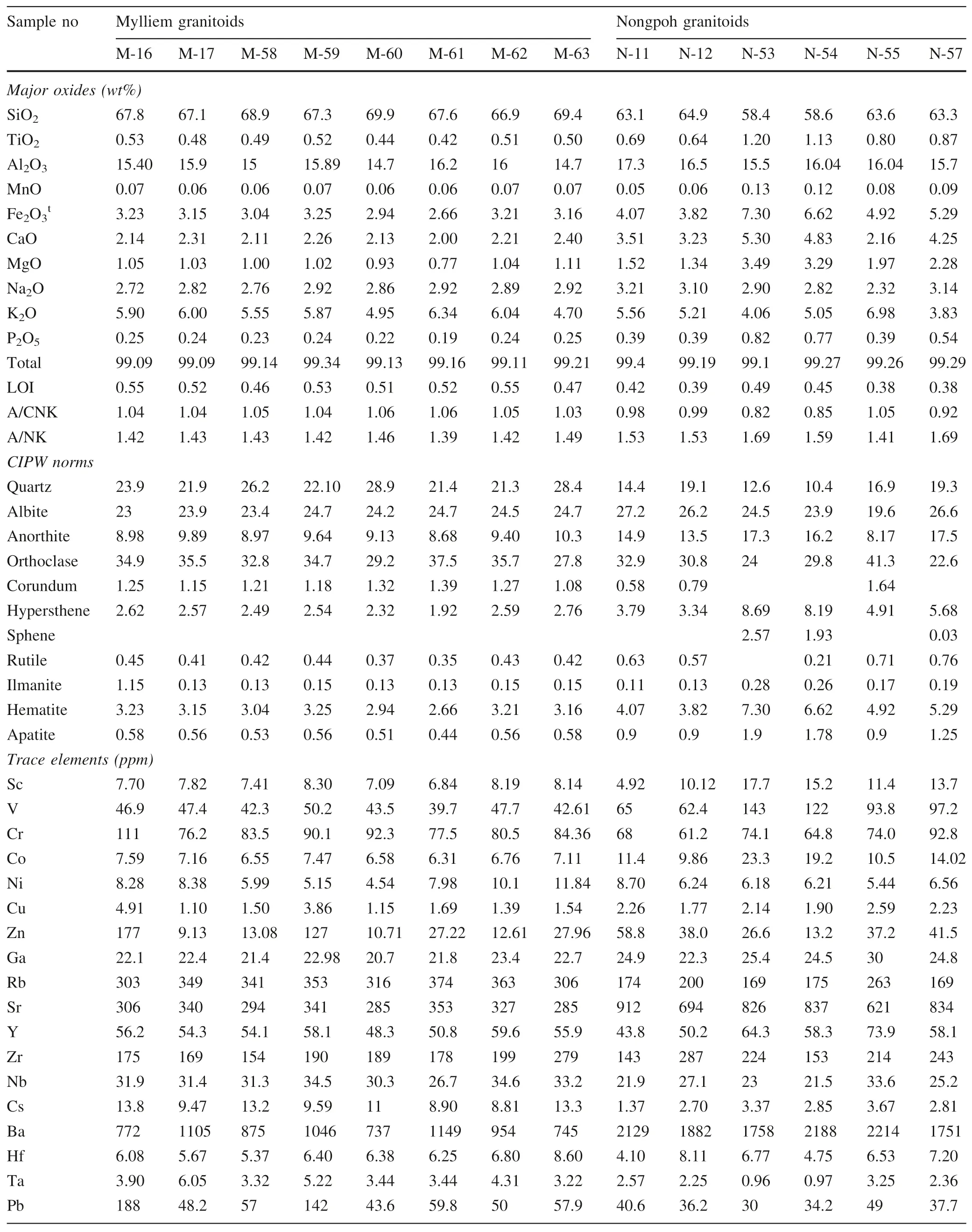
Table 1 Whole-rock geochemical analyses of the granitoids from Mylliem and Nongpoh plutons of Shillong Plateau,Northeast India along with calculated CIPW normative mineralogy
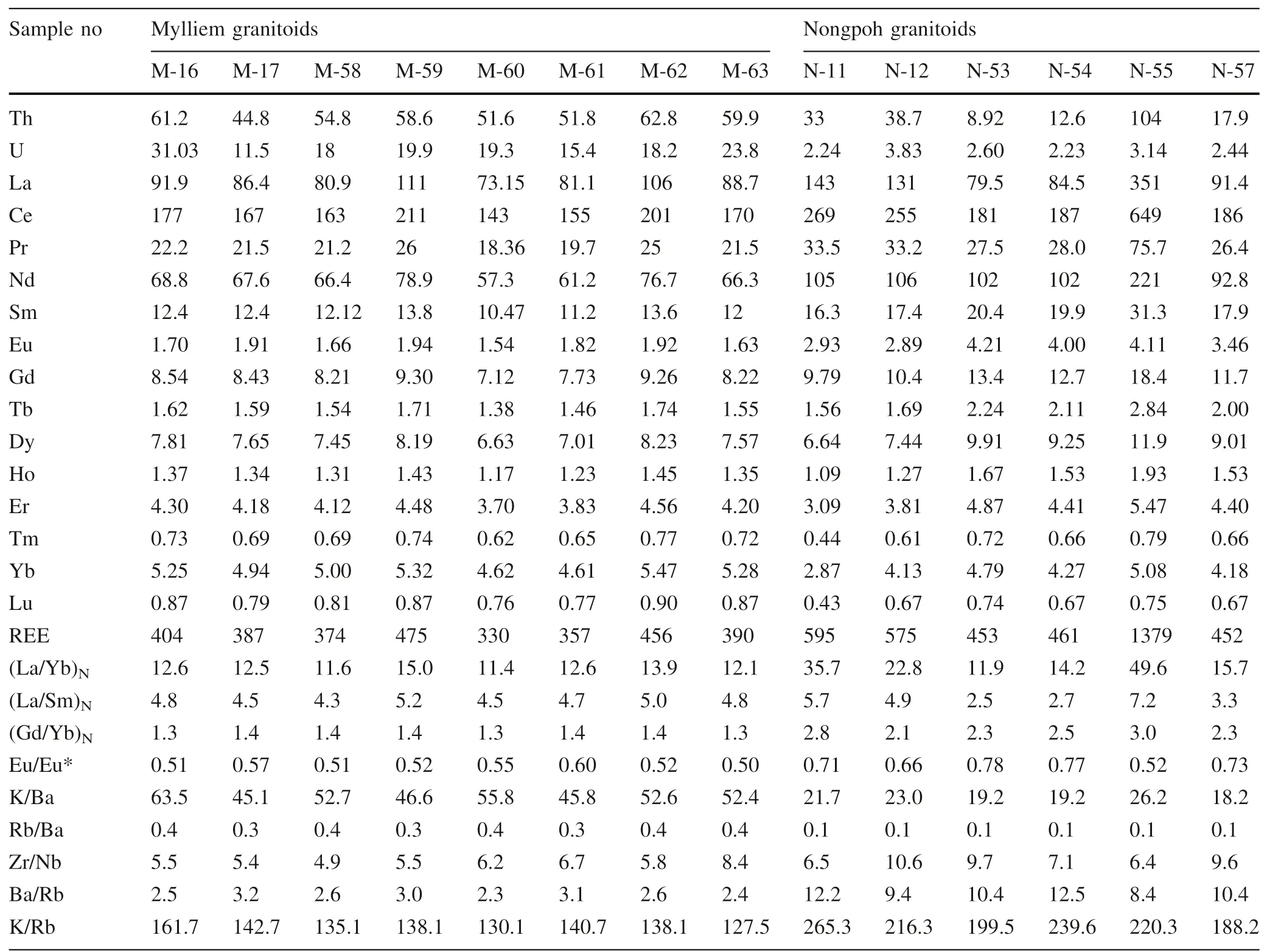
Table 1 continued
The granitoids of both Nongpoh and Mylliem plutons do not show much difference in their mineralogy and textures.These are coarse-grained and porphyritic in nature and are made up predominantly of K-feldspar,plagioclase,quartz,and biotite.Prismatic microcline and lath shaped plagioclase occur as phenocrysts and display carlsbad and polysynthetic twins respectively(Fig.4a,e).The groundmass is composed of anhedral quartz,biotite,and plagioclase with a minor abundance of hornblende and pyroxene.Sphene and zircon occur as common accessory minerals in the studied rocks;the Nongpoh granitoids additionally contain apatite and ilmenite.The granitoid samples have perthitic and antiperthitic textures with well-developed exsolution lamellae of plagioclase and K-feldspars respectively(Fig.4e,f).Myrmekitic intergrowth of quartz and plagioclase is common in the studied granitoid samples(Fig.4b,d);however,the Mylliem granitoids display a relatively higher density of the texture.Minor occurrences of sericite and chlorite are observed.In the QAP diagram(Fig.5a)after Streckeisen(1976),all the studied Nongpoh granitoid samples plot within the field of quartz-monzonite while six Mylliem granitoid samples plot within the field of granite except for two samples which plot within the field of granodiorite(Fig.5a),indicating higher abundance of modal quartz in the granitoids of Mylliem pluton than those of Nongpoh pluton.Further,myrmekitic intergrowths of fine crystals of quartz and plagioclase are observed more in Mylliem granitoids which might lead the point counting slightly biased towards quartz.Based on microscopic observations and QAP plot,the granitoids of Mylliem pluton are referred to as Mylliem granites(MG);while the granitoids of Nongpoh pluton are referred to as Nongpoh quartz-monzonites(NQM).
5 Whole-rock compositions
5.1 Major elements
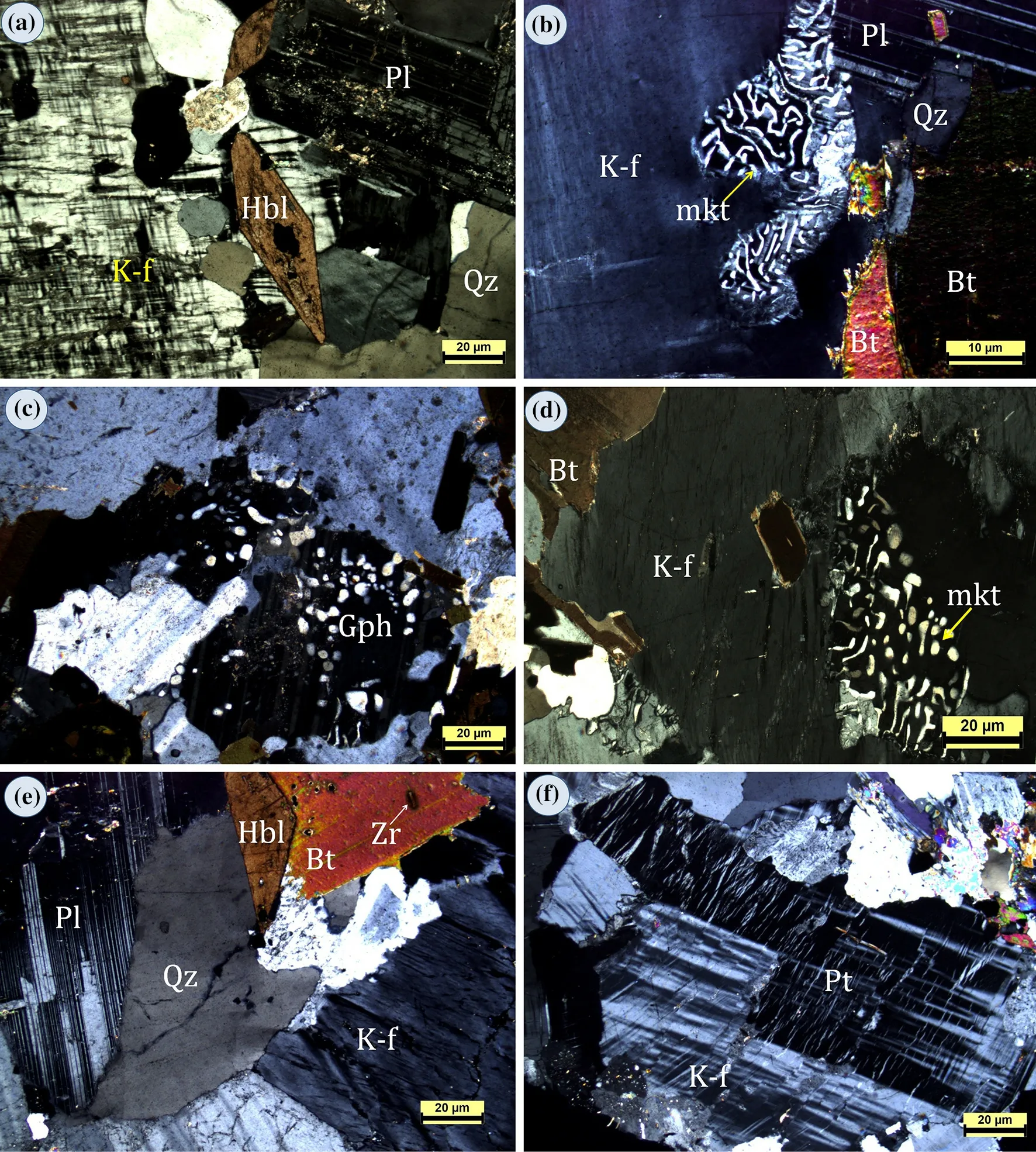
Fig.4 Photomicrographs of the granitoids of Nongpoh and Mylliem Plutons under cross-polarized light.The Nongpoh granitoids show hypidiomorphic(a).myrmekitic(b).and graphic textures(c).The Mylliem granitoids show myrmekitic(d).hydidiomorphic(e).and perthitic(f).textures.Mineral abbreviations:Pl:plagioclase;Pt:microcline perthite;Qz:quartz;Bt:biotite;K-f:K-feldspar;Hbl:hornblende;Zr:zircon;Gph:graphic texture;mkt:myrmekitic texture
NQMs are less siliceous(SiO2=58.4–64.9 wt%)than MG with much higher SiO2(66.9–69.9 wt%).NQM however,has the higher concentrations of CaO,MgO,Al2O3and Fe2O3than MG;but they have similar abundances of K2O(MG=4.7 to 6.34 wt%;NQM=3.83–6.98 wt%),and average total alkalis(K2O+Na2O:NQM=8.03 wt%;MG=8.52 wt%).A clear compositional gap between NQM and MG in many major elements is observed in Harker variation diagrams(Fig.6a).The alumina saturation index A/CNK[=Al2O3/(CaO+Na2O+K2O),mol]values of MG ranges between 1.03 and 1.06 and exhibit weakly peraluminous characteristics(Fig.7b).The NQM samples with A/CNK values ranging between 0.82 and 1.05 are transitional from metaluminous to weakly peraluminous(Fig.7b).In the Harker variation diagrams,(Fig.6a),the NQM samples show a negative correlation for Fe2O3t,CaO,P2O5,TiO2,MnO and MgO against SiO2except for Al2O3,Na2O and K2O which plot scattered(Fig.6a).By contrast,MG samples display sharp negative correlations of Al2O3and K2O contents against SiO2,while other oxides show clustered plots against SiO2with no definite trends(Fig.6a).In the normative Ab-An-Or diagram(O’Connor 1965;Barker 1979)the studied samples of NQM predominantly plot within the field of Quartz-Monzonite except for one sample which plots on the boundary with Granodiorite(Fig.5b).The samples of MG,however,plot along the boundary between Quartz-Monzonite and Granite fields(Fig.5b).In the Q-ANOR diagram(Fig.5c)the MG samples plot within the field of Granites(Syenogranite and Monzogranite),while NQM samples plot from Quartz-Syenite through Quartz-Monzonite to Granodiorite fields.Based on the modal QAP diagram(Fig.5a),normative Or-Ab-An diagram(Fig.5b);Q-ANOR diagram(Fig.5c),A/CNK versus A/NK diagram(Fig.7b)and SiO2versus(Na2O+K2O)–CaO diagram(Fig.7a),MG may be defined as high-K,alkali-calcic,and weekly peraluminous granites and the NQM may be defined as high-K,alkalicalcic,metaluminous to weekly peraluminous quartzmonzonites.
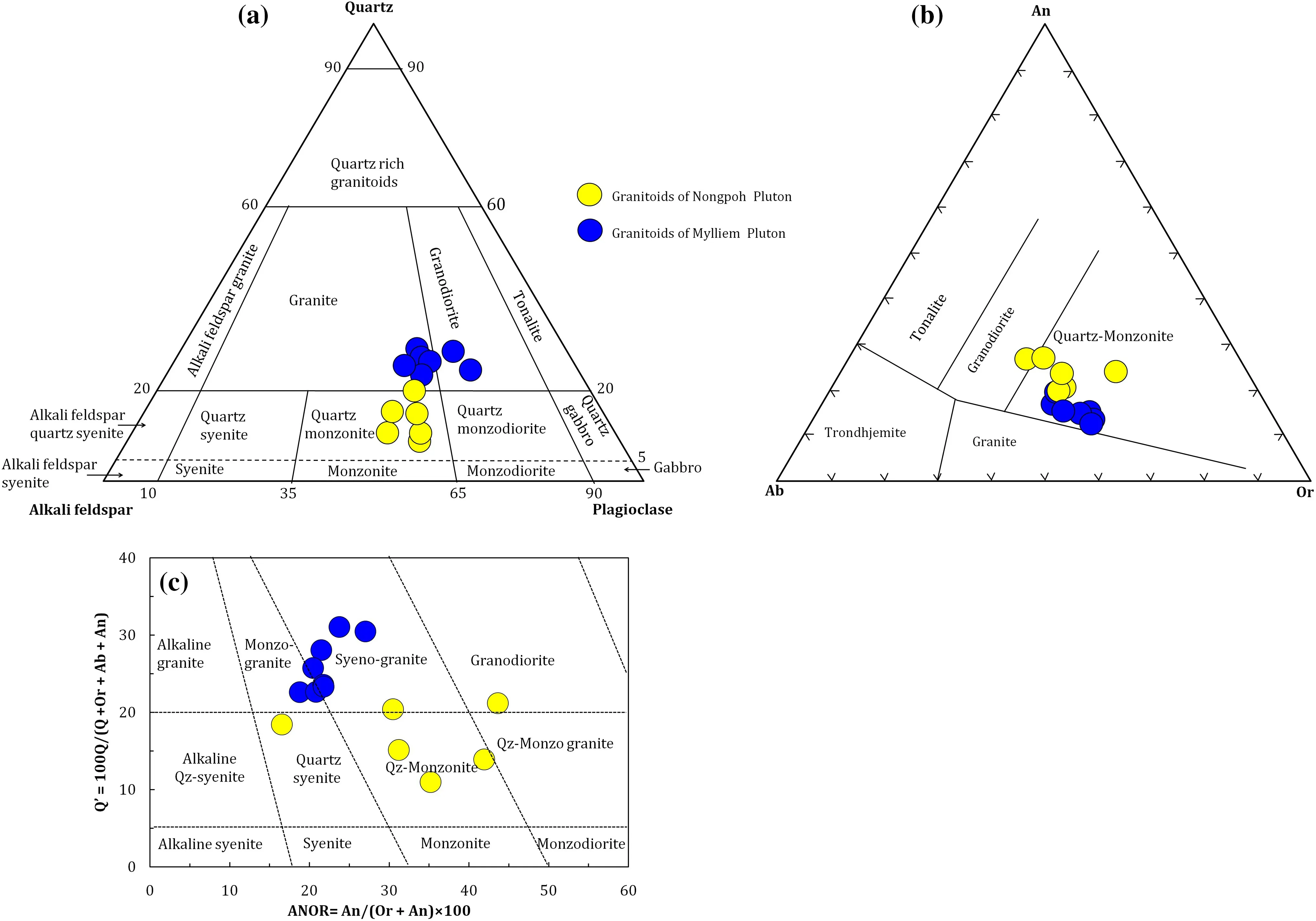
Fig.5(a)IUGS modal(after Streckeisen 1976),(b)Normative An–Ab–Or(after O’Connor 1965;Barker 1979)and(c)normative Q′-ANOR(after Streckeisen and LeMaitre 1979)classification diagrams of the granitoids of Nongpoh and Mylliem Plutons
5.2 Trace elements
Both NQM and MG samples are enriched in large ion lithophile elements(LILEs)(Rb,Sr,Ba)and high field strength elements(HFSEs)(Zr,U,Th,Y,and Ga).The Harker variation diagrams for the selected LILEs(Rb,Ba,Sr)and HFSEs(Zr,Nb,Th,Ga,U)of the studied granitoids are plotted against SiO2(Fig.6b).MG samples show a nearly perfect negative correlation for Rb,Ba,Zr,Nb,and Ga;positive correlation for U,a mild negative correlation for Sr against SiO2,however,Th does not show any definite trend(Fig.6b).By contrast,the NQM samples display mild positive correlation trends for Rb,Th,and Nb and strong negative correlation for Sr and Ga against SiO2(Fig.6b).

Fig.6 Harker variation diagrams for selected(a)major oxides and(b)trace elements for the Nongpoh and Mylliem granitoids.Symbols are as used in Fig.5
Primitive mantle(PM)normalized(PM values after Sun and McDonough 1989)multi-element variation diagram for all the studied granitoids displays enriched and fractioned patterns with LILEs enriched up to 60–700 times PM and HFSEs up to 8 to 30 times PM and negative anomalies at Ba,Nb,Ce,Sr,P,Zr and Ti indicating fractionation of feldspar,apatite and Fe-Ti oxides(Fig.8).NQM samples show distinctive enrichment of LILEs like Ba,La,Ce,Sr and Nd and HFSEs like Pr Sm,Eu,Ti,P,and Dy compared to MG(Fig.8).The MG samples,,however,show enrichment of HFSEs like Nb,Ta,Yb,and Lu compared to NQM and display positive anomalies in Rb,Th,U,and Pb(Fig.8).The NQM samples are characterized by higher total rare earth elements(REE)content(∑REE=452–596 ppm)compared to those of MG(∑REE=330–475 ppm).One NQM sample(N-55)has conspicuously high REE abundance of 1379 ppm.in the Harker variation diagram,MG samples show a gentle negative correlation between total REE(∑REE)and SiO2but,NQM samples plot scattered(Fig.6a).The chondrite normalized REE patterns for all the studied samples are enriched and strongly fractionated with light REE(LREE)enrichment and heavy REE(HREE)depletion.The LREE enrichment of the MG and NQM samples are almost similar and are of the order of 300–700 times chondrite while HREEs of MG and NQM samples are of the order of 30 to 40 times and 15 to 20 times chondrite respectively.The samples of NQM exhibit strongly fractionated REE patterns[(La/Yb)N=11.9–35.7],associated with more fractionated LREEs(La/Sm)N=2.5–5.7)and un-fractionated(relatively flat)HREE’s[(Gd/Yb)N=2.1–3.0](Fig.9).The sample N-55 displays a highly erratic fractionated pattern with(La/Yb)N=49.6.The MG samples,however,display relatively lesser degree of fractionation with(La/Yb)Nratios ranging from 11.4 to 15.0,associated with less fractionated LREEs[(La/Sm)N=4.3–5.2]and more fractionated HREEs[(Gd/Yb)N=1.3–1.4]than NQM samples(Fig.9).On the REE patterns,strong negative Eu anomalies(Eu/Eu*:NQM=0.52–0.78;MG=0.50–0.60)are evident for all the studied samples.

Fig.6 continued
6 Discussions
6.1 Geochemical classification
Both MG and NQM samples display magnesian character and occur conspicuously within the field of I-type granites in the FeO*/(FeO*+MgO)versus SiO2discrimination diagram of Frost et al.(2001)(Fig.7c).In the(Na2-O+K2O-CaO)versus SiO2plot of Frost et al.(2001),the studied granitoids show predominantly alkali-calcic affinity and occur within the field of I-type granitoids(Fig.7a).In the Molar A/NK versus A/CNK plot(after Chappel and White 1992),all the samples of NQM and MG show metaluminous to weakly peraluminous nature(A/CNK<1.1)(Fig.7b).Therefore the studied NQM and MG samples with lower SiO2and Na2O+K2O content(<9 wt%)(subalkaline),lower FeO*/Feo*+MgO(magnesian),K2O/Na2O(avg:NQM=1.80,MG=1.98),and TiO2/MgO(avg:NQM=0.40,MG=0.49)ratios;remarkably higher abundances of Al2O3,MgO and CaO,Al2O3-+CaO>15 wt%and A/CNK<1.1,typically exhibit the major element characteristics of highly fractionated I-type granitoids(e.g.Chappell 1999;Chen et al.2000;Wu et al.2003a,b;Li et al.2007;Qiu et al.2008;Zhu et al.2009;Tao et al.2013).The studied granitoids show decreases in P2O5when SiO2contents are high(Fig.6a),which is considered an important distinguishing feature of I-type granites from S-type granites(Wolf and London 1994).Apatite reaches saturation in metaluminous and weakly peraluminous melts(A/CNK<1.1)but remains highly soluble in strongly peraluminous melts and is successfully used in many studies(e.g.Chappell 1999;Li et al.2003;Wu et al.2003a).The trace elemental characteristics of the granitoids including depletion of Nb,Ta,Ti,Ba,Sr,and P and enrichment of Rb,Th,and U also point to their fractionated I-type affinity.The trends of increase in Th and Y against increasing Rb for MG and NQM samples(Fig.10a,b),also conform to the typical I-type granite evolution trend.Furthermore,the studied granitoids plot around the fractionated I-type field in the Nb versus 10,000*Ga/Al and Zr versus10,000*Ga/Al plots of Whalen et al.(1987)suggesting their fractionated I-type affinity(Fig.10c,d).Thus,we consider the studied NQM and MG samples are of highly fractionated I-type granitoids.
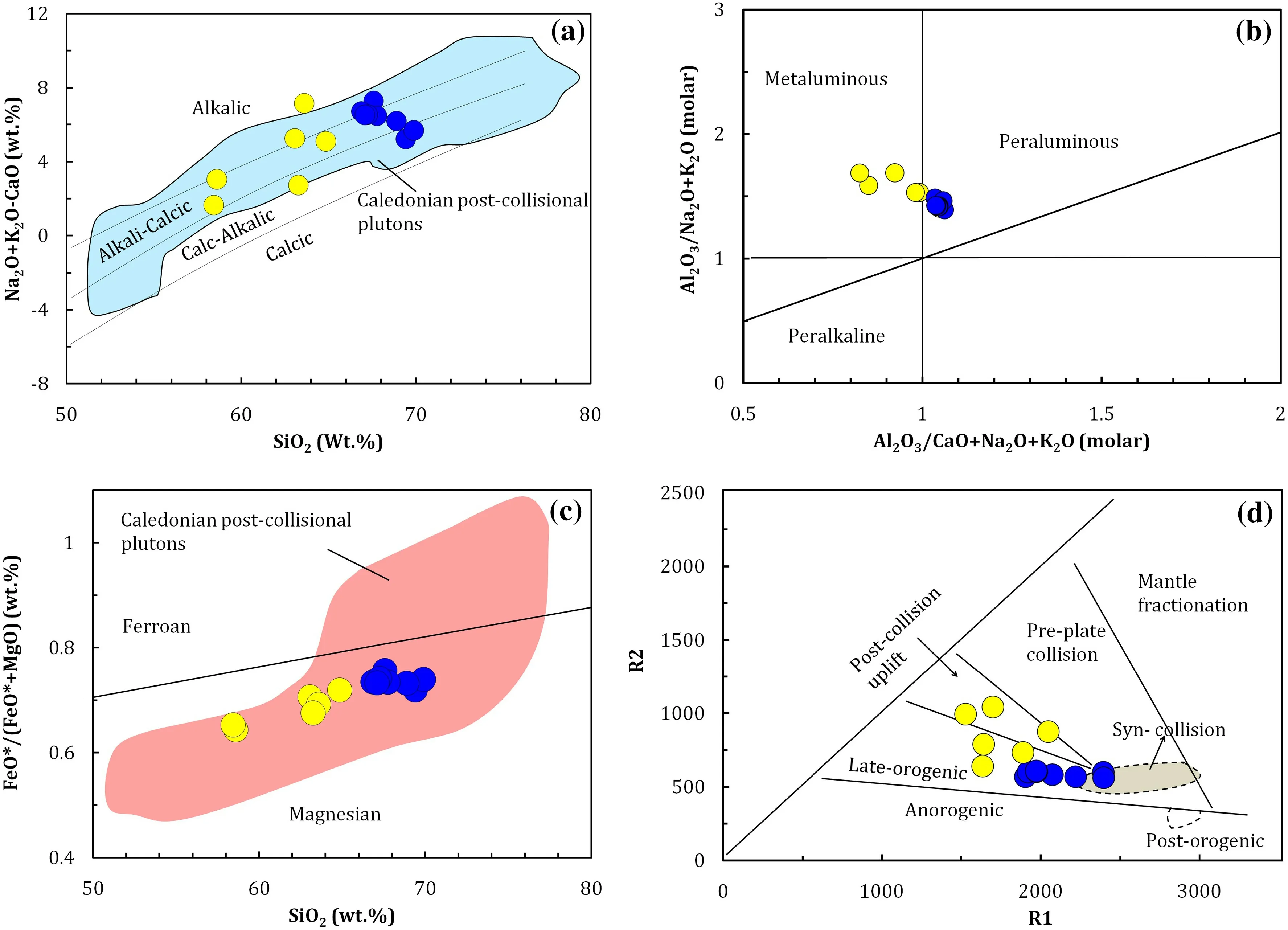
Fig.7 Discrimination diagrams for the granitoids the Nongpoh and Mylliem plutons(a)Na2O+K2O–CaO versus SiO2 diagram(after Frost et al.2001);(b)molar Al2O3/(Na2O+K2O)versus molar Al2O3/(CaO+Na2O+K2O)diagram(after Chappel and White 1992);(c)FeO*/(Feo*+MgO)versus SiO2(after Frost et al.2001)and(d)R1[4Si–11(Na+K)–2(Fe+Ti)]–R2[6Ca+2 Mg+Al)multicationic diagram(after de la Roche et al.1980 and later modified by Batchelor and Bowden 1985).Symbols are as used in Fig.5

Fig.8 Primitive mantle-normalized multi-element variation diagram for the Nongpoh and Mylliem granitoids.Primitive mantle values are after Sun and McDonough(1989).Symbols are as used in Fig.5

Fig.9 Chondrite-normalized REE patterns for granitoids of Nongpoh and Mylliem plutons.The normalization values are from Sun and McDonough(1989)

Fig.10 Trace element classification diagrams(a)Th(ppm)versus Rb(ppm)and(b)Y(ppm)versus Rb(ppm)(after Li et al.2007),(c)Nb(ppm)versus 10,000*Ga/Al,and(d)Zr(ppm)versus 10,000 Ga/Al(after Whalen et al.1987)for the Nongpoh and Mylliem granitoids.Symbols are as used in Fig.5
6.2 Petrogenesis
Both Nongpoh and Mylliem plutons were emplaced by independent magmatic pulses which are evident from their crystallization ages of 506.7±7 Ma(Kumar et al.2017)and Ca.480 to 430 Ma(Yin et al.2010)respectively.The petrographic and geochemical characteristics of the NQM and MG samples as described above are consistent with those of highly fractionated I-type granitoids,genetically unrelated to each other.To constrain the petrogenesis of highly fractionated I-type granites,several processes are hypothesized including:(a)differentiation of mantlederived mafic magma(Chiaradia 2009;Li et al.2009);(b)partial melting of a mixed source rock produced by intercalation of underplated mafic magma in lower crustal rocks(Wu et al.2003a,b;Li et al.2007),and(c)mixing of mantle-and crustal derived magmas,which,in turn,underwent fractional crystallization(Chen et al.2000;Kemp et al.2005;Qiu et al.2008;Zhu et al.2009;Tao et al.2013).The Harker variation diagrams for major oxides and trace elements against SiO2for the NQM and MG samples display a clear compositional gap which suggests the granitoid types were evolved from compositionally different magma.The major oxide data including the SiO2,MgO,CaO and Al2O3contents of the studied granitoids suggest that the NQM samples were derived from a less evolved magma while MG samples were derived from a strongly evolved magma.In general,the samples of MG and NQM display enriched LILEs and LREEs,depleted HFSE and HREE and pronounced negative anomalies at Ba,Nb,Ti,and Ta,Eu(Figs.8,9).The extreme enrichment of incompatible elements in both the granitoid types may arise from the partial melting of an enriched lithospheric mantle source metasomatised during a previous subduction event prior to melting(Chakrabarti et al.2007;Sami et al.2017).Higher values of K/Ba and Rb/Ba and significantly lower values of Zr/Nb,Ba/Rb and K/Rb,in the MG samples compared to those of NQM samples,indicate that MG has undergone stronger fractionations of plagioclase and K-feldspar compared to NQM.Similar observations are also made from the Multielemental diagram where the samples of MG display more pronounced negative anomalies at Eu,Ba,Ta,Nb,Sr,P,Zr,and Ti compared to the samples of NQM(Fig.8),reflecting higher degrees of fractionation of plagioclase,K-feldspar,apatite,zircon and Fe-Ti oxides from the MG magma and a lesser degree of fractionation of these phases from the NQM magma.It thus appears that crystal fractionation was one of the most important magma modifying process for the studied granitoid types.In addition to fractional crystallization mixing with crustal melts also appears to be a dominant process in the magmatic evolution of the granitoids.High concentrations of Th(NQM:8.9–104 ppm;MG:44.8–62.8 ppm),Pb(NQM:30–49 ppm;MG:43.6–188 ppm)and U(NQM:2.23–3.83 ppm;MG:11.5–31 ppm),clearly indicate involvement of crustal materials,although of varied compositions,for the magmatic evolution of NQM and MG.MG samples display more pronounced U,Th,and Pb positive spikes compared to the NQM samples(Fig.8)suggesting the involvement of more felsic crustal material in their source magma.Occasional occurrences of MMEs in Nongpoh pluton against higher occurrences of MMEs in Mylliem pluton additionally suggest that magma mixing may have played some role in the petrogenesis of the granitoids of both the plutons.Consequently,the geochemical variation in the granitoids of both the plutons can be explained by fractional crystallization coupled with the mixing of crustal melts.We,therefore,consider that the parental magma for both the plutons are linked to a post-collisional lithospheric extension and thinning,which caused an upwelling of the hot asthenospheric mantle and in turn induced partial melting of the overriding enriched lithospheric mantle.Parental magma for the granitoid types can also be produced through partial lithospheric delamination and upwelling of the hot asthenosphere,causing extensive melting of the subcontinental mantle lithosphere(e.g.Avigad and Gvirtzman 2009;Farahat et al.2011).The Nongpoh pluton was most likely formed by strong fractional crystallization of a hybrid magma formed due to mingling and mixing of both mantle-derived melts and melts of lower crustal melting triggered by underplating of mantle melts.Mylliem Pluton,however,was emplaced later to Nongpoh Pluton and bears more evolved and felsiccrustal signatures.It was probably formed by extensive fractional crystallization of a hybrid magma with both mantle-derived melt and melt of middle crustal melting due to interaction with hot ascending magmas and decompression driven by crustal thinning during the extensional stage.
6.3 Tectonic setting
In the Rb versus Y+Nb and Nb versus Y tectonic discrimination diagrams of Pearce et al.(1984)the samples of NQM and MG appeared to be within plate granites(WPG)(Fig.11a,b)and occur conspicuously within the field of Post-collisional granitoids of Pearce(1996)(Fig.11a).In the FeO*/(FeO*+MgO)versus SiO2(Fig.7c)and(Na2-O+K2O–CaO)versus SiO2plots(Fig.7a),the NQM and MG samples plot well within the compositional fields of Caledonian post-collisional or post–orogenic granitoids(fields after Frost et al.2001).The dominantly post-collisional nature of the studied samples as revealed from the plots of Pearce(1996)and Frost et al.(2001)are also consistent with the inferences drawn from the R1–R2 multi-cationic diagram of de la Roche et al.(1980)(modified by Batchelor and Bowden 1985)in which the MG samples plot in the field of late-orogenic group,while the NQM samples plot within the fields of late-orogenic to post-collision uplift granite group(Fig.7d).We,therefore,consider that the studied granitoids of Nongpoh and Mylliem plutons were generated in post-collisional extension setting following the collision of India,Australia and Antarctica during the assemblage of the Eastern Gondwana landmass.
6.4 Geodynamic implications
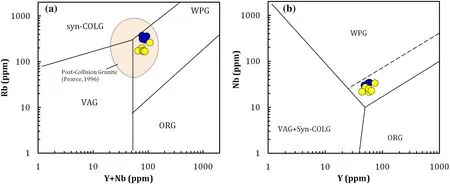
Fig.11(a)Rb versus Y+Nb and(b)Nb versus Y tectonic discrimination diagrams(after Pearce et al.1984)for the granitoids from Nongpoh and Mylliem plutons of Shillong Plateau.Symbols are as used in Fig.5.VAG:volcanic arc granites;ORG:ocean ridge granites;WPG:within plate granites;syn-COLG:syn-collision granites
Several studies on the formation of Gondwana supercontinent suggest that the final amalgamation of east-and west-Gondwana landmasses at around 620–520 Ma followed by the closure of the Mozambique Ocean,resulting in Pan-African orogenies(Meert and Van der Voo 1997;Kroner et al.2000;Collins and Windley 2002;Meert 2003;Abdel-Rahman 2019).East Gondwana landmasses were comprised of an ill-defined collage of continental blocks represented by India,Seychelles,Sri Lanka,Madagascar,East Antarctica,and Australia and west Gondwana landmasses comprised of Africa and South America.Magmatism related to extensional setting within several Pan-African domains across the world including Arabian Nubian Shield,southern Madagascar,southern India,Sri Lanka and part of Dronning Maud Land in Antarctica during the amalgamation between East and West Gondwana are well known(Kroner et al.1999;Collins et al.2000;Yellappa and Rao 2018).The Pan-African Orogeny and its related magmatism and high-grade metamorphism are well established by several studies in Shillong Plateau(e.g.Ghosh et al.2005;Chatterjee et al.2007,2011;Majumdar and Dutta 2016;Kumar et al.2017).As discussed above,highly fractionated I-type granitoids of Nongpoh and Mylliem plutons related to mixing of mantle melts and lower and middle crust-derived melts,were emplaced at about 506.7±7 Ma and Ca.480–430 Ma respectively within Shillong Plateau in a post-collisional extension setting following the final amalgamation of east and west Gondwana blocks.Several workers have documented similar tectonics and extensional related origin of highly fractionated I-type granites(Wu et al.2003a,b;Zhu et al.2009;Huang et al.2013;Zhou et al.2016;Zhang et al.2018).Granite plutons of Pan-African equivalents with geochemical characteristics similar to Nongpoh and Mylliem plutons in SP are well described in Arabian Nubian Shield,Brazilian shield and several parts of the world(Jackson et al.1984;Eyal et al.2004;Kroner and Stern 2004;Sami et al.2017).
7 Conclusions
On the basis of field study,petrography,and whole-rock geochemical characteristics of the granitoids of Nongpoh and Mylliem plutons of Shillong Plateau,the conclusions derived on the genesis and evolution of the granitoids are summarized as:
1.Nongpoh and Mylliem plutons within Shillong Plateau in Northeast India consist of medium-to coarsegrained porphyritic quartz-monzonites(NQM)and granite(MG)emplaced at 506.7±7 Ma and Ca.480 to 430 Ma respectively in response to Pan-African orogeny.
2.Variation diagrams classify the NQM samples as high-K,alkali-calcic,metaluminous to weakly peraluminous granitoids and MG samples as high-K,alkali-calcic,weakly peraluminous granitoids.
3.Mineralogic,petrographic,and geochemical data demonstrate that the studied rocks are highly fractionated I-type granitoids,suggesting a significant mantle contribution which experienced fractional crystallization of several phases during magmatic evolution.
4.Parental magma for the granitoids was generated during a period of post-collisional extensional tectonic setting and thinning induced asthenosphere upwelling which triggered partial melting of mantle late in the cycle of Pan-African orogeny and subsequently evolved due to mixing of mantle-derived melts with crustal components of varied composition and fractional crystallization.
5.NQM evolved by partial melting of the lower crust while MG evolved by partial melting of the middle crust.
AcknowledgementsThe authors thank the editor and anonymous reviewers for the constructive reviews and suggestions which has enhanced the quality of the earlier version of the manuscript.They also thank the Head of Dept.of Earth Science,Assam University,Silchar,India for extending Laboratory facilities to carry out the work.They are also thankful to the Directors of National Geophysical Research Institute,Hyderabad,India and NCESS Thiruvananthapuram,Kerala,India for the geochemical analysis.This research is financially supported by the Department of Science and Technology,Govt.of India under the Inspire Research Fellowship Programme(File No.:DST/Inspire Fellowship/2016/IF160812).
Compliance with ethical standards
Conflict of interestThe corresponding author declares that there is no conflict of interest.
杂志排行
Acta Geochimica的其它文章
- Early Silurian Wuchuan-Sihui-Shaoguan exhalative sedimentary pyrite belt,South China:constraints from zircon dating for K-bentonite of the giant Dajiangping deposit
- Niobium-tantalum oxide minerals in alluvial placer deposits from the Ngoura area,East-Cameroon
- Development of a 100 MPa water-gas two-phase fluid pressurization device
- Helium and argon isotope geochemistry of the Tibetan Qulong porphyry Cu-Mo deposit,China
- Translocation and distribution of mercury in biomasses from subtropical forest ecosystems:evidence from stable mercury isotopes
- Coprecipitation of metal ions into calcite:an estimation of partition coefficients based on field investigation
